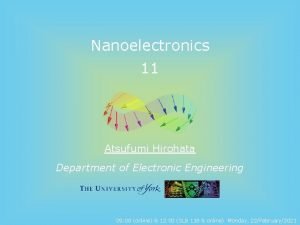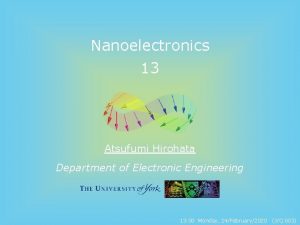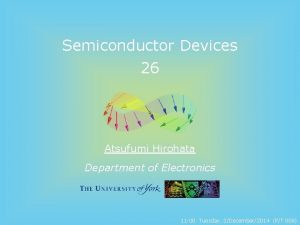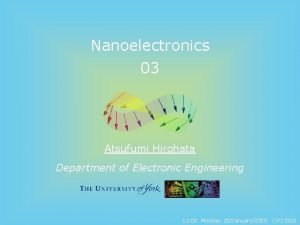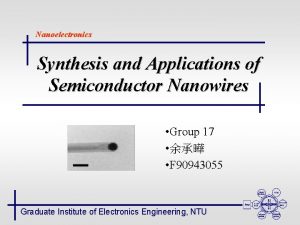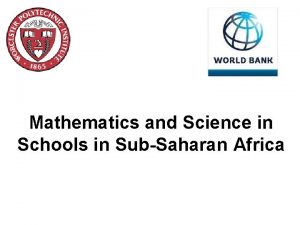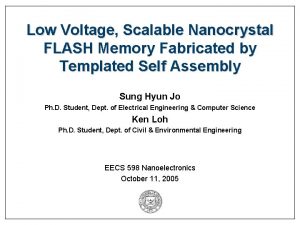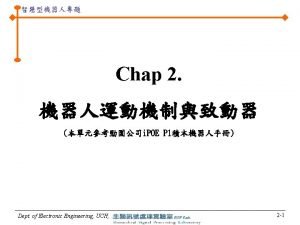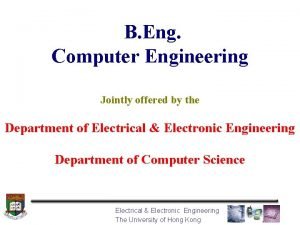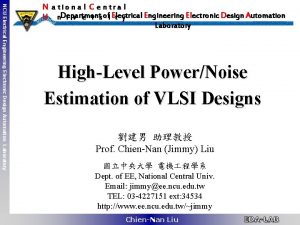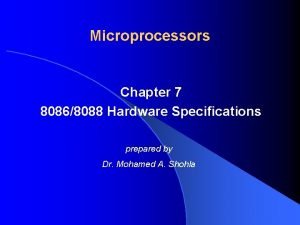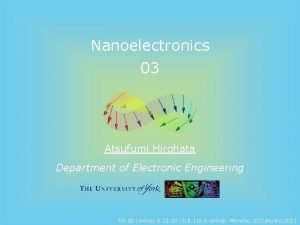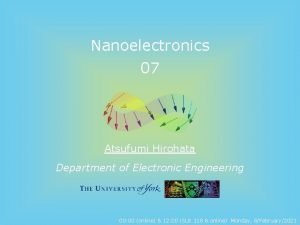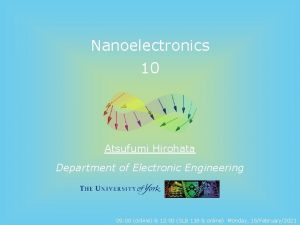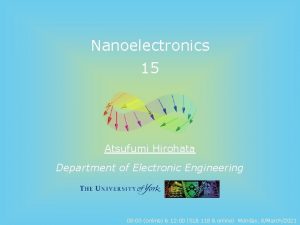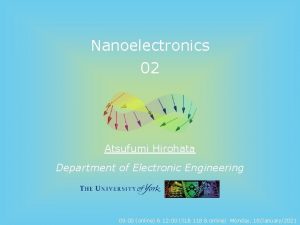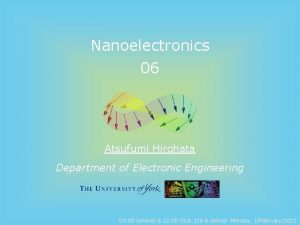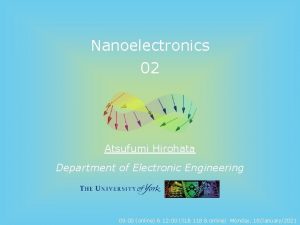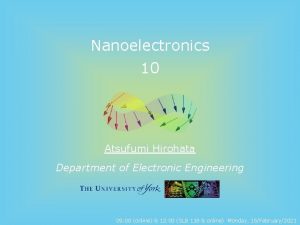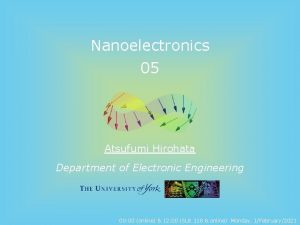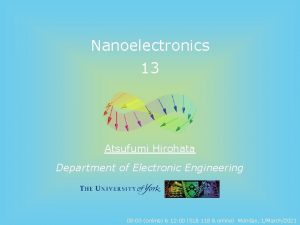Nanoelectronics 13 Atsufumi Hirohata Department of Electronic Engineering















- Slides: 15

Nanoelectronics 13 Atsufumi Hirohata Department of Electronic Engineering 13: 00 Monday, 24/February/2020 (J/Q 003)

Quick Review over the Last Lecture Gate Voltage Input Output ( Spin-transfer torque ) FM / SC hybrid Structures Magnetic tunnel junctions (MTJ) All metal and spin valve structures Interface Ohmic / Schottky barriers Tunnel barriers Ohmic (no barrier) Spin carriers SC Tunnel barriers Non-magnetic metals FM / 2 DEG Schottky diodes Spin FET Spin LED Spin RTD MOS junctions Coulomb blockade structures SP-STM Supercond. point contacts Spin RTD Johnson transistors Spin valve transistors Device applications * After M. Johnson, IEEE Spectrum 37, 33 (2000).

Contents of Nanoelectonics I. Introduction to Nanoelectronics (01) 01 Micro- or nano-electronics ? II. Electromagnetism (02 & 03) 02 Maxwell equations 03 Scholar and vector potentials III. Basics of quantum mechanics (04 ~ 06) 04 History of quantum mechanics 1 05 History of quantum mechanics 2 06 Schrödinger equation IV. Applications of quantum mechanics (07, 10, 11, 13 & 14) 07 Quantum well 10 Harmonic oscillator 11 Magnetic spin 13 Quantum statistics 1 V. Nanodevices (08, 09, 12, 15 ~ 18) 08 Tunnelling nanodevices 09 Nanomeasurements 12 Spintronic nanodevices

13 Quantum Statistics 1 • • • Classical distribution Fermi-Dirac distribution Bose-Einstein distribution

Classical Distribution Maxwell-Boltzmann distibution : In the classical theory, the same types of particles can be distinguished. Every particle independently fills each quantum state. In order to distribute N particles to the states 1, 2, . . . with numbers of N 1, N 2, . . . To distribute Ni particles to the states Gi is Gi. Ni, and hence the whole states are Microscopic states in the whole system W is By taking logarithm for both sides and assuming Ni and Gi are large, we apply the Stirling formula.

Classical Distribution (Cont'd) In the equilibrium state, Again, by applying the Stirling formula, Here, with using By using and Now, the partition function is

Classical Distribution (Cont'd) Therefore, By substituting this relationship into Here, = 1/k. BT Gi : degree of degeneracy of eigen enrgy Ei * http: //www. wikipedia. org/

Fermi-Dirac / Maxwell-Boltzmann Distribution Electron number density : Fermi sphere : sphere with the radius k. F Fermi surface : surface of the Fermi sphere Increase number density classical Maxwell-Boltzmann distribution quantum mechanical Fermi-Dirac distribution (small electron number density) (large electron number density) * M. Sakata, Solid State Physics (Baifukan, Tokyo, 1989).

Fermi Energy Fermi-Dirac distribution : E T=0 T≠ 0 EF Pauli exclusion principle At temperature T, probability that one energy state E is occupied by an electron : f(E) : chemical potential (= Fermi energy EF at T = 0) k. B : Boltzmann constant 1 T=0 T 1 ≠ 0 1/2 T 2 > T 1 0 E

Fermi velocity and Mean Free Path Fermi wave number k. F represents EF : Fermi velocity : Under an electrical field : Electrons, which can travel, has an energy of ~ EF with velocity of v. F For collision time , average length of electrons path without collision is Mean free path Density of states : g(E) Number of quantum states at a certain energy in a unit volume 0 E

Density of States (DOS) and Fermi Distribution Carrier number density n is defined as : T=0 g(E) f(E) EF 0 E T≠ 0 g(E) f(E) n(E) 0 EF E

Fermi-Dirac Distribution In the Fermi-Dirac distribution, 1 quantum state can be filled by 1 particle. Fermi particle (spin 1/2) For the entire wavefunction : Particle exchange induces a sign change of the wavefunction. For a 2 -Fermi-particle system, due to the exchange characteristics, the wavefunction is expressed as If the 2 particles satisfy the same wavefunction, Pauli exclusion principle

Bose-Einstein Distribution In the Bose-Einstein distribution, 1 quantum state can be filled by many particles. Bose particle (spin 1, 2, . . . ) For the entire wavefunction : Particle exchange does not induce a sign change of the wavefunction. For a 2 -Bose-particle system, due to the exchange characteristics, the wavefunction is expressed as If the 2 particles satisfy the same wavefunction, f(E) 0 E

Bose-Einstein Distribution (Cont'd) Difference between Bose-Einstein and Maxwell-Boltzmann distributions : * http: //hyperphysics. phy-astr. gsu. edu/hbase/quantum/disbex. html

Quantum Statistics In quantum mechanics, the same types of particles cannot be distinguished : By exchanging coordinate systems, Hamiltonian (operator) does not change : P : coordinate exchange operator Diagonalization between H and P By assuming the eigenvalue for P to be , Since twice exchange of the coordinate systems recover the original state, Therefore, (symmetric exchange) Bose-Einstein statistics Bosons integer spins (asymmetric exchange) Fermi-Dirac statistics Fermions half-integer spins
 Atsufumi hirohata
Atsufumi hirohata Fermi velocity
Fermi velocity Shottky
Shottky Atsufumi hirohata
Atsufumi hirohata Atsufumi hirohata
Atsufumi hirohata Atsufumi hirohata
Atsufumi hirohata Atsufumi hirohata
Atsufumi hirohata Nanoelectronics
Nanoelectronics What is semiconductor
What is semiconductor Nanoelectronics
Nanoelectronics Is the electronic exchange of money or scrip
Is the electronic exchange of money or scrip Electronic news gathering and electronic field production
Electronic news gathering and electronic field production Electronic engineering
Electronic engineering Electronic engineering
Electronic engineering Electronic engineering
Electronic engineering Electronic engineering
Electronic engineering
